Welcome to a pre-Christmas LinkSwarm! (Pro-tip: The week before Christmas is the bad time to try rolling out a new diet.)
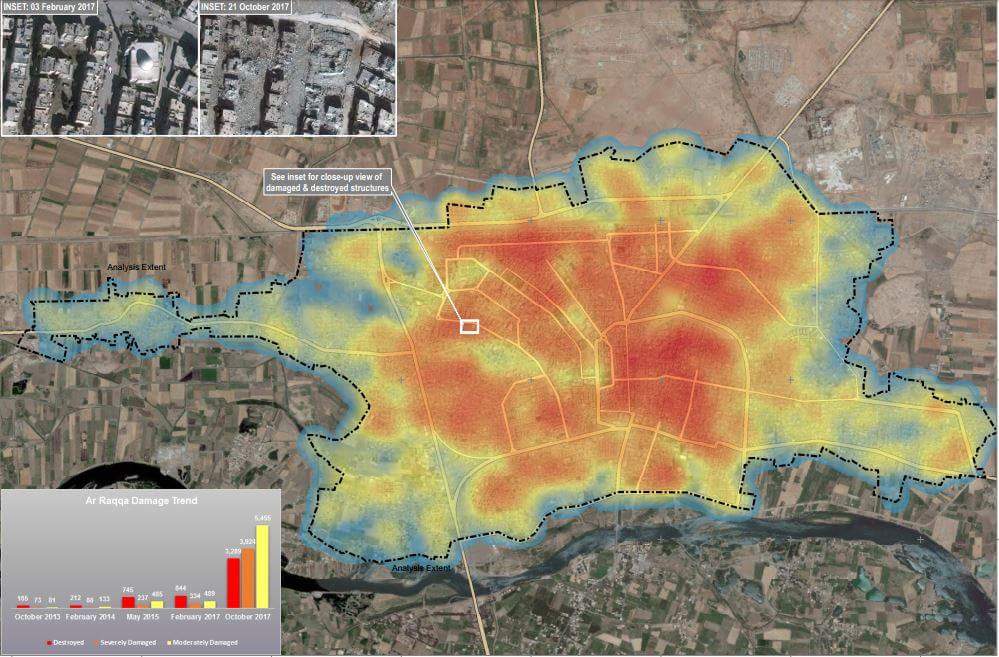
I would say this week has been a bear, but it’s more like a bear claw…
Merry Christmas!

Welcome to a pre-Christmas LinkSwarm! (Pro-tip: The week before Christmas is the bad time to try rolling out a new diet.)

I would say this week has been a bear, but it’s more like a bear claw…
Merry Christmas!

After having secured the Syrian border, Iraq has declared the war against the Islamic State over. Syria strongman Bashar Assad’s patrons the Russians have likewise declared Syria liberated from the Islamic State as well. Both of these statements are slightly premature, but not by much.
Right now isis.livemap shows the Islamic State disjointed into five enclaves, two in sparsely populated desert areas in Syria, one similar area in Iraq, and two small enclaves along the Euphrates in Syria southeast of Deir ez-Zor, both of which are being systematically crushed by the forces of Assad’s Syrian government of the Kurdish-led and U.S.-backed Syrian Democratic Forces.
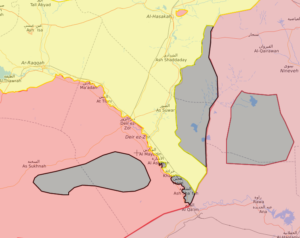
Once those small pockets are crushed, the military war against the Islamic State is effectively won, though expect it to linger on as yet another international jihadist terrorist organization, a tiny shadow of its former self, until the last of it’s many affiliates are either crushed or pledge allegiance to another leader.
More Islamic State news:
The onetime capital of the short-lived caliphate of the Islamic Republic of Iraq and Syria has been completely liberated by the U.S.-backed Syrian Democratic Forces:
A US-backed alliance of Syrian Kurdish and Arab fighters says it has taken full control of so-called Islamic State’s one-time “capital” of Raqqa.
Syrian Democratic Forces (SDF) spokesman Talal Sello said the fighting was over after a five-month assault.
Clearing operations were now under way to uncover any jihadist sleeper cells and remove landmines, he added.
An official statement declaring victory in the city and the end of three years of IS rule is expected to be made soon.
IS made Raqqa the headquarters of its self-styled “caliphate”, implementing an extreme interpretation of Islamic law and using beheadings, crucifixions and torture to terrorise residents who opposed its rule
The city also became home to thousands of jihadists from around the world who heeded a call to migrate there by IS leader Abu Bakr al-Baghdadi.
“On Tuesday morning, the SDF cleared the last two major IS positions in Raqqa – the municipal stadium and the National Hospital.”
Here are a series of maps (captured from Syria.livemap.com) that paint a picture of how the battle unfolded:
June 9:
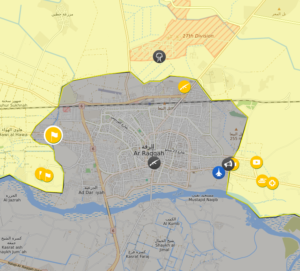
July 12:
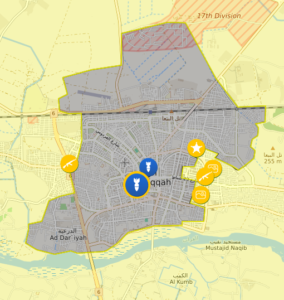
August 13:
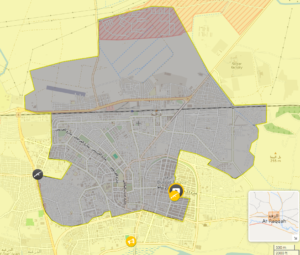
August 25:
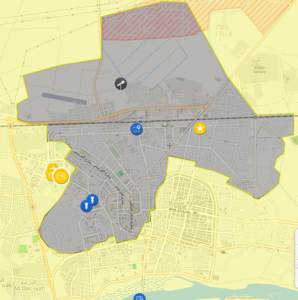
September 5:
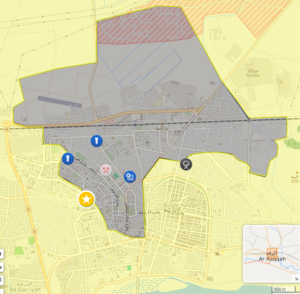
October 8:
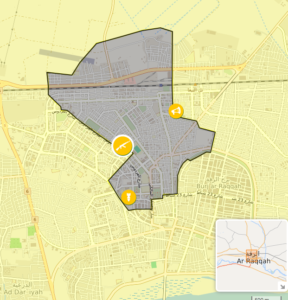
October 14:
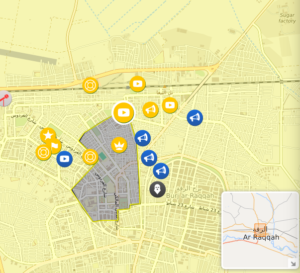
Some additional perspective from Robin Wright in The New Yorker:
“There are other places for ISIS to go and survive, but there’s something special about Syria and Iraq and the Fertile Crescent,” [Will] McCants, a fellow at the Brookings Institution, said. “It’s the theatre of prophecy. It’s where the apocalyptic drama unfolds. It’s the heartland of the historic caliphate, and it’s the scene of the final end-of-times drama, as predicted by Islamic scripture. Nowhere else in the Islamic world compares with it.”
McCants said that the fall of Raqqa, a city that was once home to more than two hundred thousand Syrians but is now mostly destroyed, will weaken the group’s ability to recruit fighters and inspire attacks. “The fight will go on, and ISIS will morph into an insurgency and may try to reëstablish another state, but, for now, it’s a crushing blow,” he said. “ISIS put all its chips on creating a state and taking territory as proof of its divine mandate. Some of its followers now have to have doubts.“
At its height, the Islamic State was about the size of Indiana, or the country of Jordan, with eight million people under its control. ISIS transformed the world of jihadism by recruiting tens of thousands of followers from five continents—faster, in larger numbers, and from further corners of the Earth than any other modern extremist group. The caliphate was formally declared by Abu Bakr al-Baghdadi on June 29, 2014, from a pulpit in the Grand Mosque of Mosul, the largest city under ISIS control. It, too, was liberated, in July, after a gruesome nine-month offensive by Iraqi security forces.
ISIS still holds bits and pieces of territory in both countries. But it no longer rules. Baghdadi, an Islamic scholar who was detained by the U.S. military in Iraq for almost a year, in 2004, as prisoner number US9IZ-157911CI, has not been sighted in public since the unveiling of his caliphate.
At a press conference on Tuesday, Army Colonel Ryan Dillon, a spokesman for the U.S.-led coalition supporting the campaign against ISIS, said, “Over all, ISIS is losing in every way. We’ve devastated their networks, targeted and eliminated their leaders at all levels. We’ve degraded their ability to finance their operations, cutting oil revenues by ninety per cent. Their flow of foreign recruits has gone from about fifteen hundred fighters a month down to near zero today. ISIS in Iraq and Syria are all but isolated in their quickly shrinking territory.” Brett McGurk, the Special Presidential Envoy for the Global Coalition to Counter ISIS at the State Department, tweeted that an estimated six thousand fighters had died in the battle for Raqqa.
There’s talk that the Islamic State’s surviving foreign fighters will relocate to Libya, where a civil war has ranged off and on since Moammar Gadhafi’s ouster/execution (thanks, Obama).
Now if only the various factions fighting the Islamic State in Iraq and Syria can finish it off there rather than turning on each other…
“Islamic State is on the verge of defeat in Syria’s Raqqa and a deal has been reached to evacuate civilians and Islamic State fighters, but not foreign militants, the U.S-led coalition fighting ISIS said on Saturday.”
Here’s the Syria LiveMap screencap from October 8:

And here’s a screencap from today:

It looks like the already compacted Islamic State pocket in Raqqa has already been reduced by 80% in that time.
Here’s some video of the most recent push:
Footage from the battle of Raqqa city. pic.twitter.com/fxyIkCEHqv
— Afarin Mamosta (@AfarinMamosta) October 14, 2017
I look forward to putting up the “Raqqa Liberated” post in a day or two…
Quick update on the ongoing destruction of the Islamic State.
First, “Iraqi forces have driven Islamic State fighters from the northern city of Hawija, the militants’ final urban stronghold in Iraq, three years after they seized control of nearly a third of the country, the Iraqi government said Thursday.”
There’s still lots of fighting along the Euphrates, but the Islamic State doesn’t control any cities outside that region any more.
Second, the the final offensive against Islamic State holdouts in what remains of their territory in besieged Raqqa just began, with commanders of the U.S.-backed Syrian Democratic Forces estimating that all of Raqqa will be liberated this week.

Third, like Raqqa, Deir ez-Zor has been completely cut off from the rest of the Islamic State by both SDF and Assad’s Syrian army. SDF also captured the Islamic State’s Deir ez-Zor headquarters.
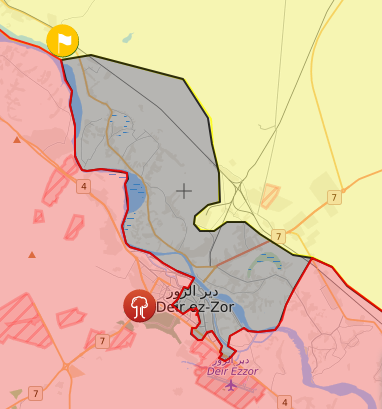
(Pictures, as usual, from http://isis.liveuamap.com/.)
In western Syria, there are conflicting reports about the remaining Islamic State pocket near Hama there. The Syrian government claims it has destroyed the last elements of the Islamic State there, while the Islamic State claims that it is attacking and gaining ground from the Hay’at Tahrir al-Sham, the rival Islamist group in the Syrian civil war that incorporates former elements of the al-Nusra Front.
In 2014, the Islamic State took and ruled vast swathes of Iraq and Syria. Now they struggle to hold on to what few cities they still control, and soon will rule over nothing at all.
That’s what this headline implies. The truth is a little less dramatic: Raqqa is on the edge of full liberation and the Islamic State is in retreat everywhere else.
Static lines of control that held for months in northern Raqqa have collapsed, as seen in this Syria Livemap screen cap:
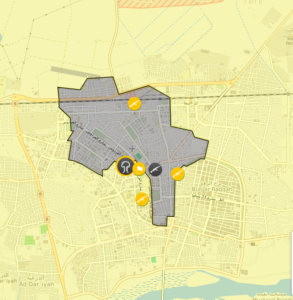
Compare that to this map from September 5:

Islamic State fighters are running out of territory in Raqqa to defend.
Here’s a video from the battle of Raqqa:
Southeast of Raqqa, Syrian government forces and the SDF are both pushing toward Deir ez-Zor.
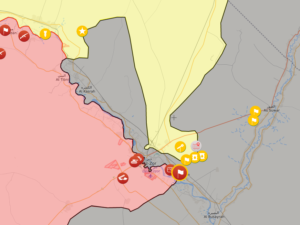
SDF also say they have captured Syria’s largest oilfield from the Islamic State near Deir ez-Zor.
Elsewhere in the theater, “Iraqi Security Forces and the Syrian Democratic Forces have cleared ISIS out of about 50,000 square miles and liberated more than 6 million people who were living under Islamic State occupation.”
Here’s a map of Iraqi forces collapsing the pocket of Islamic State forces to the southwest of Kirkuk that have been cut off from the rest of the Islamic State at least since the investment of Mosul.
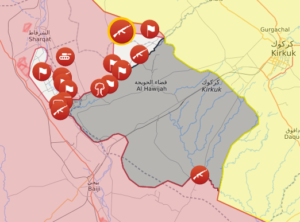
Everywhere within it’s supposed caliphate, the Islamic State is in retreat, and nowhere is it counterattacking successfully. But it still holds a lot of territory, and there’s a lot more fighting left before declaring it dead.
Bonus video: Royal Air Force drone stops Islamic State public execution:
Remember how a month ago how almost all the different Syrian factions were concentrating on crushing the last remnants of the Islamic State?
Good times, good times.
Well the good times may be over, as Russian and Syrian forces launched an airstrike against the U.S.-backed and Kurdish-led Syrian Democratic Forces northeast of Deir ez-Zor.
Both are converging on Deir ez-Zor, thought to be the de facto capital of what’s left of the Islamic State. SDF also wants to keep Assad’s forces on the western side of the Euphrates.
Here’s the situation from Syria Livemap:
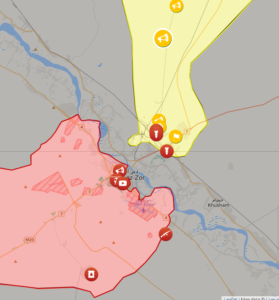
It would be nice if both sides could finish dismantling the Islamic State before launching the next war…
Before we turn our attention to North Korea, there’s still the war against the Islamic State to be won. And there’s lots of significant news there.
First, Syrian government forces have just relieved the Islamic State’s three year siege of Deir ez-Zor (AKA Deir el-Zour):
Syrian government forces and their allies reached the eastern city of Deir el-Zour on Tuesday, ending a nearly 3-year-old ISIS siege on government-held land near the Iraqi border, Syrian state TV reported.
State TV said troops advancing from the west reached the outskirts of the city and broke the siege after ISIS defenses “collapsed.”
Breaking the siege, which has been divided between an ISIS and a government-held part since January 2015, marks another victory for President Bashar Assad, whose forces have been advancing on several fronts against ISIS and other insurgent groups over the past year.
Meanwhile, the U.S.-backed, Kurdish-led Syrian Democratic Forces have taken the old city of Raqqa:
U.S.-backed forces in Syria have captured the Old City of Raqqa, the latest milestone in their ongoing assault against the self-proclaimed capital of the Islamic State’s rapidly shrinking territories, according to a U.S. military statement on Monday.
Kurdish and Arab fighters with the Syrian Democratic Forces secured the neighborhood over the weekend after vanquishing a last pocket of resistance in the city’s historic Great Mosque, the statement said.
The capture followed a grinding two-month battle for the neighborhood that has proved the toughest challenge yet of a three-month-old offensive for Raqqa, launched in June and still far from over.
Unlike in Mosul, the Old City does not lie at the heart of Raqqa and its seizure does not signify an imminent end to the fighting, said a U.S. military spokesman, Col. Ryan Dillon.
The SDF now controls about 60 percent of Raqqa, said Dillon, who would not put a timeline on how long it would take to claim the rest but predicted that weeks of fighting lie ahead.
Here are some maps (captured from Syria.livemap.com) that paint a picture of how the battle unfolded over the last few months.
June 9:

July 12:

August 13:

August 25:

September 5:

For an idea of what it’s like in Raqqa right now, this piece, originally publishing in the Wall Street Journal over a week ago, provides a pretty vivid account:
Before launching the battle to capture Islamic State’s de facto capital, the U.S.-led military coalition dropped leaflets calling on extremists to surrender. On the ground, militants were going door to door, demanding that residents pay their utility bills.
Islamic State, long bent on expanding its religious empire with shocking brutality in the form of public executions, crucifixions and whippings, is desperately focused on its own survival.
Raqqa has been a crucial part of the terror group’s self-declared caliphate. Until a few months ago, public squares were lined with decomposing bodies of those who had run afoul of Islamic State’s religious rules or bureaucracy.
Instead of ruthlessly enforcing no-smoking decrees and dress codes, though, militants now are doing whatever they can to hold on to areas still controlled by the group—and revenue needed to help keep Islamic State afloat financially.
They are so preoccupied that some women in Raqqa dare to uncover their faces in public. A few men defiantly smoke in the streets and shave their beards, current and former residents say.
When the call to prayer sounds from mosques, some residents no longer bother to go. Islamic State used to force shops to close and people to pray.
Women accused of violating Islamic State’s strict dress code were once whipped. In May, though, militants released two women unharmed after they were forced to buy new robes and all-covering face veils sold by Islamic State’s religious police for 10,000 Syrian pounds each, or a total of about $40, says Dalaal Muhammad, a sister and aunt of the women.
Ms. Muhammad, 37 years old, says her sister had to beg a family member to borrow the $40 from friends.
“They didn’t even have enough to buy bread,” she said at a camp for displaced Syrians, wearing sandals held together by twine. “They just wanted to get the money quickly because we were running out of time” to flee Raqqa.
An estimated 25,000 civilians remain trapped in Raqqa under Islamic State control, according to the United Nations, and more than 230,000 people have fled Raqqa and its suburbs since early April. On Thursday, the U.N. called for a pause in the assault so civilians can escape.
Fighters for the U.S.-backed Syrian Democratic Forces, which is leading the assault to oust Islamic State from Raqqa, say on some days they have helped dozens of civilians reach safety. Other days, no one makes it out. Militants execute smugglers helping civilians flee and those accused of collaborating with the U.S.-led coalition.
The Pentagon has estimated there are fewer than 2,500 Islamic State militants left in the city, down from about 4,500.
Militants spent months girding for the long-anticipated assault before it began in June. They dug extensive tunnels beneath streets and homes, set up snipers’ nests and planted improvised explosive devices everywhere to stop people from fleeing.
“They wanted us as human shields,” says Obaida Matraan, 33 years old, a taxi driver who escaped with his family one night just before the battle began. They carried a piece of white fabric to wave as they approached the SDF.
Before the escape, he saw on public display the bodies of executed men with signs that said “smuggler” as “a warning to others,” recalls Mr. Matraan.
In early 2014, Raqqa was the first city in Syria or Iraq to fall under Islamic State’s complete control. The group has lost about 60% of the territory it held in January 2015, including its former Iraqi stronghold of Mosul, according to analysts at IHS Markit Ltd.’s Conflict Monitor.
Even as the self-declared caliphate crumbles, Islamic State has continued to claim responsibility for deadly terror attacks around the world, including in Spain last week, in a bid to project power.
The SDF has encircled Raqqa and says it has seized more than half the area of the city. But militants are capable of striking behind the coalition’s front lines and are scrambling to hoard the little food and water left in areas they control. Much of Raqqa remains a battlefield.
The ground advance by the SDF has been aided by coalition airstrikes. At least 465 civilians have likely been killed in those airstrikes since the battle began, independent monitoring group Airwars reported.
The U.S.-led coalition said it investigates civilian casualties. Monthly reports released by the coalition show far lower estimates of civilian casualties.
Syrian activist groups estimate that at least dozens more civilians were killed during the past week. Civilians still in Raqqa say the airstrikes seem indiscriminate and kill more civilians than militants, who hide out in tunnels.
At the height of Islamic State’s control, life in Raqqa and elsewhere in the group’s territory was dictated by so many laws on everyday life that residents struggled to keep track of them.
Banned items ranged from men’s skinny jeans (too Western and provocative) to canned mushrooms (made with preservatives) to bologna (because the group said it contained pork).
Enforcement slackened as the Syrian Democratic Forces advanced toward Raqqa through the Syrian countryside and eventually surrounded the city, according to residents who fled recently.
Checkpoints thinned out as Islamic State leaders and many militant fighters abandoned the city and headed to the eastern province of Deir Ezzour, residents said. The group still holds much territory in the oil-rich region and is expected to make its last stand there.
People who have left Raqqa say militants suddenly seemed to care much more about money than morals. Islamic State’s revenue—from oil production and smuggling, taxation and confiscation, and kidnapping ransoms—is down 80% in the past two years, IHS Conflict Monitor estimates.
For months, Islamic State ordered businesses and residents to use only the caliphate’s own currency of gold and silver coins, current and former residents said. The move forced people to trade in their U.S. dollars and Syrian pounds to Islamic State, which wanted those currencies as its territory shrinks.
Mr. Matraan, the taxi driver, says Islamic State made him pay $30 for water, electricity and a landline telephone bill just weeks before his family fled.
“They would go to people’s homes and demand payment,” said Mr. Matraan, who wore a San Jose Sharks cap under the searing sun at a camp for displaced Syrians in Ain Issa, a city north of Raqqa. “In the end, their main concern was money.”
Abdulmajeed Omar, 27, says militants began fining those caught violating Islamic State’s smoking ban, rather than jailing or whipping them. Being caught with a pack of cigarettes brought a $25 fine. The fine for a carton of cigarettes was $150.
“They didn’t bother with poor people,” says Mr. Omar, who fled Raqqa before the battle and returned with the Kurdish YPG militia to fight Islamic State.
Before Ms. Muhammad fled the city, militants spent a month digging a tunnel underneath her home in the eastern neighborhood of al-Mashlab, she said. Like many of her neighbors, Ms. Muhammad was afraid to ask them what they were doing.
Inside one house in al-Mashlab, which has since been captured by SDF forces, a tunnel opening cut through the living-room floor. The fighters filled the hole with broken furniture because they weren’t sure where the tunnel led.
“We are suffering from snipers and tunnels,” said Dirghash, a Kurdish YPG commander on the city’s eastern front line who wouldn’t give his last name. “The tunnels are all in civilian homes, and we suddenly find [Islamic State militants] popping up behind us.”
On the western side of Raqqa, a warning painted in silver on the metal shutters of a motorcycle shop simply read: “There are mines.”
In captured neighborhoods, the walls already are covered with new graffiti by the YPG, the Syrian Kurdish militia that is the dominant group in the Syrian Defense Forces. Every conquering force that has swept through Raqqa since the Syrian conflict began more than six years ago has left its mark with cans of paint.
The Islamic State has also reportedly been driven from Uqayribat, its last stronghold in Hama Governorate in central Syria. What little territory they still hold there is completely cut off from the rest of the Islamic State by Syrian government forces.
Assuming both Deir ez-Zor and Raqqa both fall this month, the Islamic State is left with very little viable territory in Syria, mainly a populated strip along the Euphrates from Al Busayrah to Abu Kamal on the Iraqi border, which is some 63 miles or so.
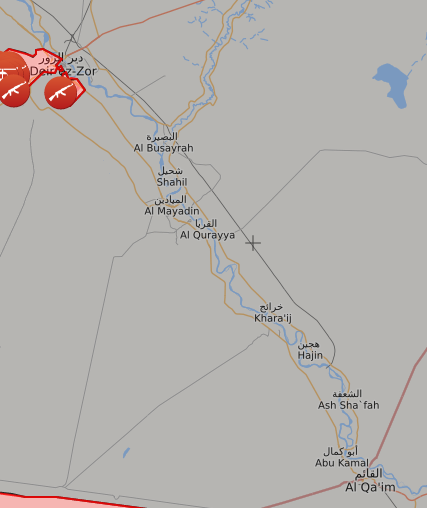
In Iraq, U.S.-supported forces also continue to make gains against the Islamic state, including the liberation of Tal Afar at the end of August. “The Iraqi forces killed over 2,000 Islamic State (IS) militants and more than 50 suicide bombers during a major offensive to free Tal Afar area in west of Mosul, officials said.” The operation is described as a “blitzkrieg” rather than the grinding urban warfare that characterized the Battle of Mosul.
Finally, the anti-Islamic State coalition received a new commander today: Lt. Gen. Paul E. Funk II, commander of III Armored Corps stationed at Ft Hood, assumed command of coalition forces, relieving Lt. Gen. Stephen Townsend, who took over in August 2016. The timing suggests a regular duty/force rotation than any change in policy.
To quote Funk: “ISIS is on the run.”
The coalition of forces fighting the Islamic State continue to make steady advances on a number of fronts:

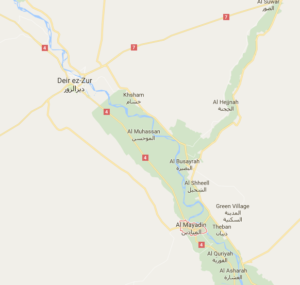
Under President Obama, U.S. Army Special Forces assigned to Syrian Democratic Forces needed special approval from Washington for virtually all tactical moves amid the politically complex theater of Americans, Arabs, Kurds, Turks and Syrians.
In Tabqa, where the city, its dam and its airfield were the objectives, the Green Berets decided they needed an airlift. Suddenly minus red tape, Arabs, Kurds and Americans were helicoptering into battle, and they quickly seized territory.
Under Mr. Obama, Islamic State terrorists could at times retreat from towns, immune from airstrikes if they used civilians as cover. The battle for Manbij in August became infamous when the SDF let 200 Islamic State fighters turn in their weapons and escape because they had threatened to kill town residents if they were not allowed to run away.
The new Trump strategy calls for surrounding towns, as opposed to pushing from one end or one side to another, in order to isolate Islamic State fighters and annihilate them.
Brett H. McGurk, special U.S. envoy to the coalition against the Islamic State who performed the same role for Mr. Obama, talked of “the delegations of authority which has made a difference in terms of the speed of execution. I think Tabqa was an example of that.”
“Our military people on the ground saw an opportunity to kind of surprise ISIS with a helicopter, moving them by helicopter, surprise them from behind and seize the airport, the dam and the town,” Mr. McGurk later told reporters at the Pentagon.
After Tabqa’s liberation, Mr. McGurk spoke to the city’s mayor, who gave a brief description of the war of annihilation.
“He also said he believes that most of these foreign fighters are now dead,” the diplomat said.
Mr. Mattis said: “No longer will we have slowed decision cycles because Washington, D.C., has to authorize tactical movements. I’ll leave that to the generals who know how to do those kind of things. We don’t direct that from here. They know our intent is the foreign fighters do not get out. I leave it to their skill, their cunning, to carry that out.”
House-by-house clearing in Raqqa:
The ruins of the Al Nuri Mosque in Mosul, from which al-Baghdadi declared his short-lived caliphate:
The Islamic State is by no means destroyed, but they’re definitely on the ropes. The defeat of the Islamic State won’t end transnational Islamic fundamentalism, but it will certainly take the wind out of their sails.
Not included in this roundup: Groups outside Islamic State territory that pledged allegiance to the Islamic State. I hope to have a separate roundup on them Real Soon Now.
Note: Post updated to remove embedded video on improvised weapons of the Battle for Mosul, as it’s been taken down for “violating YouTube’s Terms of Service,” possibly because it included Islamic State propaganda videos of weapon-making among the footage.